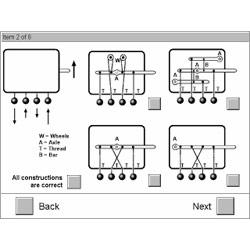
Mechanical-Technical Ability Test - MTA - 7 Year License
Model 64050
Assesses the mechanical-technical understanding using animated items (instruments, to which a construction plan must be assigned); to be used with adolescents and adults.
Test Overview
The fact that this test consists of a mostly non-verbal task, of moving images and the obvious connection to practical activities makes it work even for those respondents, who tend to have a negative opinion about tests with a "typically school-like" content.
Main area of Application
- Aptitude diagnostics.
Theoretical Background
In psychology there is a multitude of terms like "technical- constructive" or "practical-technical understanding", which are used in connection with mechanical-technical understanding. Pauli & Arnold (1972) limit the definition in the following way:
Technical understanding broadly contains the following abilities:
- To understand and describe technical drawings or instruments and to describe their usefulness.
- To recognize the functional importance of the individual parts and to explain their coaction.
- To correctly understand and describe basic technical laws (e.g. the effect of the lever), with which everybody is acquainted in daily living.
- The personal inner connection with technical problems (eagerness or revulsion).
The MTA tries to cover the above-mentioned abilities from points a-c.
Administration
In the first run 4 plans per instrument are presented. The task consists of finding the one plan, which does not allow the sequence of movements shown before (in an animation). If all four constructions allow this sequence of movements, then the answer "all constructions are correct" must be selected. In the second run, either one of the 4 plans per instrument must be selected as correct or the answer can be "all constructions are incorrect". So in the first run one incorrect plan must be discovered among the four plans presented per instrument, whereas in the second run one correct plan must be found. The test has an "item-related time-limit". This means that the next item appears automatically after a certain time interval (2 minutes) has elapsed.
Test Forms
There is one testform.
Scoring
The defined test score is the number of items solved.
Reliability
The reliability in the sense of an inner consistency is given due to the validity of the Rasch model.
The following characteristic values for reliability were calculated: splithalf-reliability r=0.87, Cronbach's alpha r=0.84 and Guttman's lambda 3 r=0.84.
Validity
Since the tasks of the MTA coincide by their content as well as formally with those of other mechanical-technical tests that were checked for their external validity, the external validity is deemed to be secure also for them.
One external validity criterion (positive / negative completed retraining in a technical profession, r=0.47) confirms the selection quality of the MTA.
Norms
The norms available are based on a sample of N=259 adults. Three additional samples are based on the data of N=556 students from vocational schools, which were further divided between professions with technical understanding (N=339) and professions without technical understanding (N=217).
Testing Time
Test phase: 40 minutes at the maximum.
VTS System Overview
The Schuhfried VTS enables computer-assisted application of a large number of highly diverse psycho-diagnostic tests and measuring procedures. In developing the system much emphasis was placed on transparent structure and largely uniform design. It is therefore simple to operate and easy to understand and does not require any special computer skills.
The VTS basic module is required for administration of any of the available tests.
The Schuhfried VTS supports the administration of both single tests and test batteries. Many of the single tests are available in different test versions. These test versions may differ, for example, in terms of test duration or difficulty or may be parallel forms. They are characterized by different parameters reflecting specific test requirements. They have been designed for administration to a specific population (e.g. psychiatric patients, children, etc.) or for special measuring purposes (e.g. repeated measurements). Test batteries are compiled from the available single tests and test versions.
